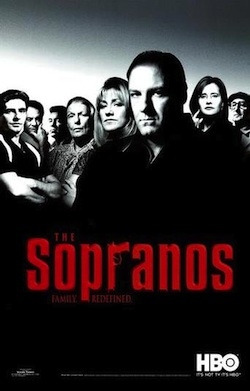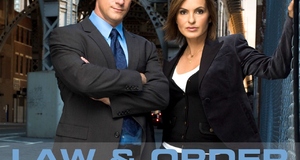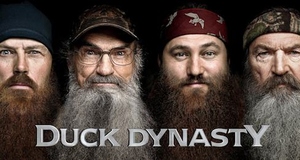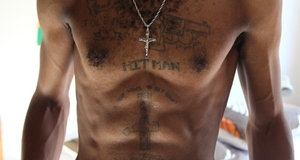In Treatment: The Casting and Bracketing of Repulsion in The Sopranos
By
2013, Vol. 5 No. 08 | pg. 1/4 | »
IN THIS ARTICLE
KEYWORDS
The Sopranos (1999-2007) opens with its lead character, Tony Soprano (James Gandolfini), unenthusiastically meeting his therapist, Dr. Jennifer Melfi (Lorrain Bracco) for the first time. He is reluctant to trust a female analyst; nevertheless, he begins a confessional narrative that reveals the extent to which the Mafia boss is willing to tell selected portions of his own personal history, but fails to understand fully their meaning and how they refer back to whom he is. Despite his resistance, the scene conveys the extent to which the Mafia boss does not fully realize and understand his own personal history. As a matter of fact, only at the end of the last season (season six is divided into two parts) does the viewer hear Tony asking his wife Carmela (Edie Falco), “Who am I? Where am I going?” after waking up from the coma that results from Uncle Junior (Dominic Chianese) shooting him in All Due Respect, last episode of season five. This identity question is crucial, even though it is formulated so late in the show. The Sopranos develops this question throughout the entire HBO TV series, through the last episode and beyond. In fact, the series’ creator and writer, David Chase, builds this central question and its unresolved answer, even when the title of the TV series suggests that this is “not the story of one protagonist, but an adventure in the plural.” (Polan, 61). But is this TV series an adventure that the extended Soprano family really shares?
Tony, as much as the TV series, is, as the title of Season 5, Episode 5 reads, the “irregular around the margins.” For Tony, rules are made to be broken. He creates his own rules in order to trespass the social boundaries in which he lives. Similarly, Chase breaks rules and conventions of TV genres to create his own work. It is quite obvious how through eighty-six episodes Tony breaks every rule. But how does Chase reach the same goal? How does he create a TV show that makes it difficult to deploy familiar labeling or genre categorization? How does Chase create a successful series where the audience cannot count on the usual and reassuring codes of the TV genre? The TV genre discourse can prove that the text of The Sopranos does not belong to any TV genre in particular (Creeber, 28).1 However, when textual analysis and extra-textual studies come together, I would argue that the unique TV genre of the The Sopranos is born (Creeber, Spring 2006, p. 84). (After all, Chase’s TV series is not conventionally or predictably understood. On the contrary, the viewer’s expectations rarely coincide with the ones of the TV series and as such, the viewer’s expectations are hardly met; see Neale, 1-3.) The uniqueness of The Sopranos TV genre does not undermine other TV genres, but it makes the point that The Sopranos is not a textual hybrid. In fact, mapping the relationships between Chase’s TV series and other TV texts shows that these relationships do not necessarily produce crossovers (Turner, 5). Operating from within genre criticism, Jason Mittel argues that TV genres do not emerge only from the text, but, rather, that “cultural practices of generic discourses” determine the genres (Mittel, 15). This essay embraces an intertextual perspective and argues that The Sopranos’ casting and reception is built around a double repurposing process. Chases uses his past professional experience, the audience’s knowledge about TV series, and its knowledge of actors whose identity is associated with specific acting roles (the “good” guys vs. the “bad” guys) to prepare the viewer to enjoy a formula he or she likes, but does not expect to have a new twist. I argue that in part three (3.1) Chase borrows “from existing, and presumably popular forms” and combines them “in a new configuration” (White, 46). According to the secular point of view of this essay Chase’s repurposing process is a form of conversion. In some instances, the conversion occurs, when Chase changes the moral nature of the roles that actors like John Heard, Robert Loggia, Joe Pantoliano, and Steve Van Zandt usually play and strips them of their emblematic roles and identities. In other cases, Chase chooses actors whose success is specifically based on Mafia movies. For instance, in the cast of Goodfellas (Martin Scorsese, 1990), and The Godfather (Francis Ford Coppola, 1972), the majority of secondary characters play key roles in The Sopranos. Chase’s second type of conversion is not necessarily based on the actors’ fame, but on their intermediality. Most of these actors played and play in both cinema and television. In fact, Chase converts movie actors playing secondary roles--such as Lorrain Bracco playing Jewish Karen Hill married to Irish Mafioso Henry Hill (Ray Liotta)--and transforms them in TV actors who play major roles in The Sopranos. In other words, watching Goodfellas from 1999 on, when The Sopranos begins, is a different experience. The audience cannot watch Scorsese’s film without thinking about how young “Dr. Melfi” looked in 1990. Despite the audience’s familiarity with these actors and roles, the conversion persuades the viewer to accept the actors’ “Sopranization.” The viewer’s acceptance of the characters’ “Sopranization” occurs, when the viewer brackets and isolates his or her own feelings and ideas in order to avoid the prejudices of type casting. It would not be surprising, if the viewer had learned this approach from Dr. Melfi. In fact, she is the one who must bracket her own prejudices and repulsion for Tony in order to understand and treat him without falling for the Mafioso’s stereotypical reputation (Yontef, 18). Therefore, the first part of the repurposing process lies in the double casting choices. Such a supposed “process of ‘controlled’ transformation” in The Sopranos certainly justifies a reinvestigation of TV genres, more specifically of Chase’s TV series, which, as this essay argues, becomes a TV genre of its own. As previously discussed, Chase uses one successful aspect within the “margins” of different TV genres to create a success of a different nature. What happens, though, when TV series belonging to different genres repurpose The Sopranos or the formula of its success? In the second half of part three (3.2), this essay argues that this opposite repurposing makes the viewer witness and accept at the same time the “de-Sopranization” of characters and narrative. In other words, Chase’s recipe for success wins even when The Sopranos’ cast, motifs, and narrative elements are repurposed in other TV genres, such as sit-coms, reality shows, (medical) drama TV series, etc. If characters’ “Sopranization” annihilates Mafia stereotypes through the viewer’s bracketing of his or her personal point of view, characters’ “de-Sopranization” re-establishes those stereotypes. In order to demonstrate the repurposing of The Sopranos TV genre and the characters’ “de-Sopranization,” this essay considers the failed case of Falcone (2000), HBO drama In Treatment (2008-2010), and Showtime comedy drama Nurse Jackie (2009-Present) respectively. The “Sopranization” of an actor recognized for a definite acting role in a specific media for the majority of his/her career creates a singular identity for the actor, a role for which he or she is famous and remembered. The “de-Sopranization” of an actor allows him or her to play multiple roles with which he or she can be associated. Hence, recalling the secular reading and understanding of Tony’s identity and the TV series itself, through “Sopranization” and “de-Sopranization” a Sopranos actor become “triune”--singular and multiple, in this order. Singular and Multiple, Tony is “Triune”“No man can wear one face to himself and another to the multitude without finally getting bewildered as to which may be true,” Tony reads in Bowdoin College’s Admissions Building, when he accompanies his daughter Meadow (Jamie-Lynn Sigler) on a college tour. The identity split suggested in Nathaniel Hawthorne’s quote bewilders Tony. The American writer’s words evoke an internal fracture, a sense of fragmentation with which Tony is quite familiar. Chase shows Tony’s fragmented self, starting from the opening credits. Tony is visually revealed through a series of extreme close-ups of his right hand on the wheel, as he drives back to New Jersey from New York, the cigar he is smoking, the unglamorous right-pinky ring, and his eyes in the rear-view mirror before the smoke of his cigar obscures them. The names of all the other actors “sink” and become invisible over the sequence, wiped away to the right, as the tracking shot from Tony’s car travels left. Even episode 22 of season 13, “Poppa’s Got a Brand New Badge” from The Simpsons plays on The Sopranos cast’s invisibility. At the end of this episode, where Homer Simpson, become the savior of Springfield from crime, has to protect himself from the Mafia boss, Fat Tony and his crew, who want him dead. In the part of the episode under examination, Fat Tony and his clan get on a minivan. The entire sequence, which is a parodic reference of The Sopranos’ opening sequence, ignores Tony’s men completely. They become invisible, while a series of close-ups again slowly reveals Fat Tony’s cartoonish physicality, as if he were alone to carry through the murder. Tony is portrayed as being beyond everything and everyone. He is omnipotent in almost a “divine” sense. Then, the reference to Coppola’s The Godfather is almost inevitable. In line with the secular reading this essay embraces, Tony becomes the “God” – father. He is not like Satan, the Christian evil, as Bruce Plourde argues (Blourde, 68-69). Tony is the split character, whose omnipotence knows no confines. He is the “Father” of those who have faith in him. He is their savior. He knows being “above all of it” and, thus he is also alone and isolated, as his nephew Christopher (Michael Imperioli) points out in Cold Cuts. If he is the “God”- father, Tony’s role as the “Almighty” is established and undisputable. Then, asking the question, “Who is Tony Soprano?” means asking, “Who is ‘God’?” “God,” as much as Tony, is the demiurge, the artisan of the universe that “He” himself created and finally runs. But what is Tony’s universe? Tony’s universe is the Soprano family, which does not include only Carmela, Meadow, A.J (Robert Iler), Livia (Nancy Marchand), Uncle Junior, etc. It includes also the members of the business/Mafia family that Tony runs. Yet, arguing that Tony is the boss of two families is a fundamental oversight. There is only one family, the Sopranos. Certainly, Tony is divided between the actual Soprano family and the mafia family, but his own mafia associates are addressed as uncles, sons, and nephews (interestingly all male characters as if they were his “apostles!”) within the Soprano family circle. Then, the integration of non-blood related characters in the Soprano family blurs the border between the two groups and the Sopranos become an extended family, as the title of the TV series seems to suggest. It is not by chance that the viewer refers to and remembers the “apostles” by their first name, as if they were considered members of Tony’s communion. Tony is the “pacifier,” the “Father” of all the characters that gravitate around him, as if they were all his kids. The kids, Silvio (Steve Van Zandt), Christopher, Paulie (Tony Sirico), Big Pussy (Vincent Pastore), Vito (Joseph R. Gannascoli), Ralph (Joe Pantoliano), Bobby (Angelo Massagli) always play billiards, darts, poker, and poke fun of people in the backroom of Tony’s strip club, Bada Bing. Christopher is the one who eats lollipops and is jealous, as much as Paulie, of those peers who steal Tony’s attentions from him. Tony’s wife, Carmela, is no less childish. Tony easily “buys” her with a generous monthly allowance and gifts of all sorts, comparable to expensive toys.Continued on Next Page » Suggested Reading from Inquiries Journal
Inquiries Journal provides undergraduate and graduate students around the world a platform for the wide dissemination of academic work over a range of core disciplines. Representing the work of students from hundreds of institutions around the globe, Inquiries Journal's large database of academic articles is completely free. Learn more | Blog | Submit Latest in Film & Media |

 In this essay I argue that The Sopranos is an adventure in the singular, the story of one protagonist, Tony Soprano, who is at once singular and multiple. He is the boss of the DiMeo crime family--later referred to as the Soprano crime family--and as such he is admired and respected. Yet, his identity is far from being so simple. Thinking about Tony Soprano as just the Mafia boss, who is the main character of the TV series, is a mistake. At the same time, defining Tony as multiple only on the basis of his private roles as son, husband, father, etc. is another simplistic reading of his character. The simultaneous existence of Tony’s apparent singularity and hidden multiplicity is acknowledged from the first therapy session with Dr. Melfi, but remains unrealized by the viewer or Tony himself through the show’s conclusion. Thus, showing how Tony’s inner multiplicity unfolds in the narrative is a dead end. The first part of this essay explores Tony’s singularity and multiplicity in theological terms, arguing that Tony is the “triune God,” singular and multiple indeed, a sort of paradox.
In this essay I argue that The Sopranos is an adventure in the singular, the story of one protagonist, Tony Soprano, who is at once singular and multiple. He is the boss of the DiMeo crime family--later referred to as the Soprano crime family--and as such he is admired and respected. Yet, his identity is far from being so simple. Thinking about Tony Soprano as just the Mafia boss, who is the main character of the TV series, is a mistake. At the same time, defining Tony as multiple only on the basis of his private roles as son, husband, father, etc. is another simplistic reading of his character. The simultaneous existence of Tony’s apparent singularity and hidden multiplicity is acknowledged from the first therapy session with Dr. Melfi, but remains unrealized by the viewer or Tony himself through the show’s conclusion. Thus, showing how Tony’s inner multiplicity unfolds in the narrative is a dead end. The first part of this essay explores Tony’s singularity and multiplicity in theological terms, arguing that Tony is the “triune God,” singular and multiple indeed, a sort of paradox.
















